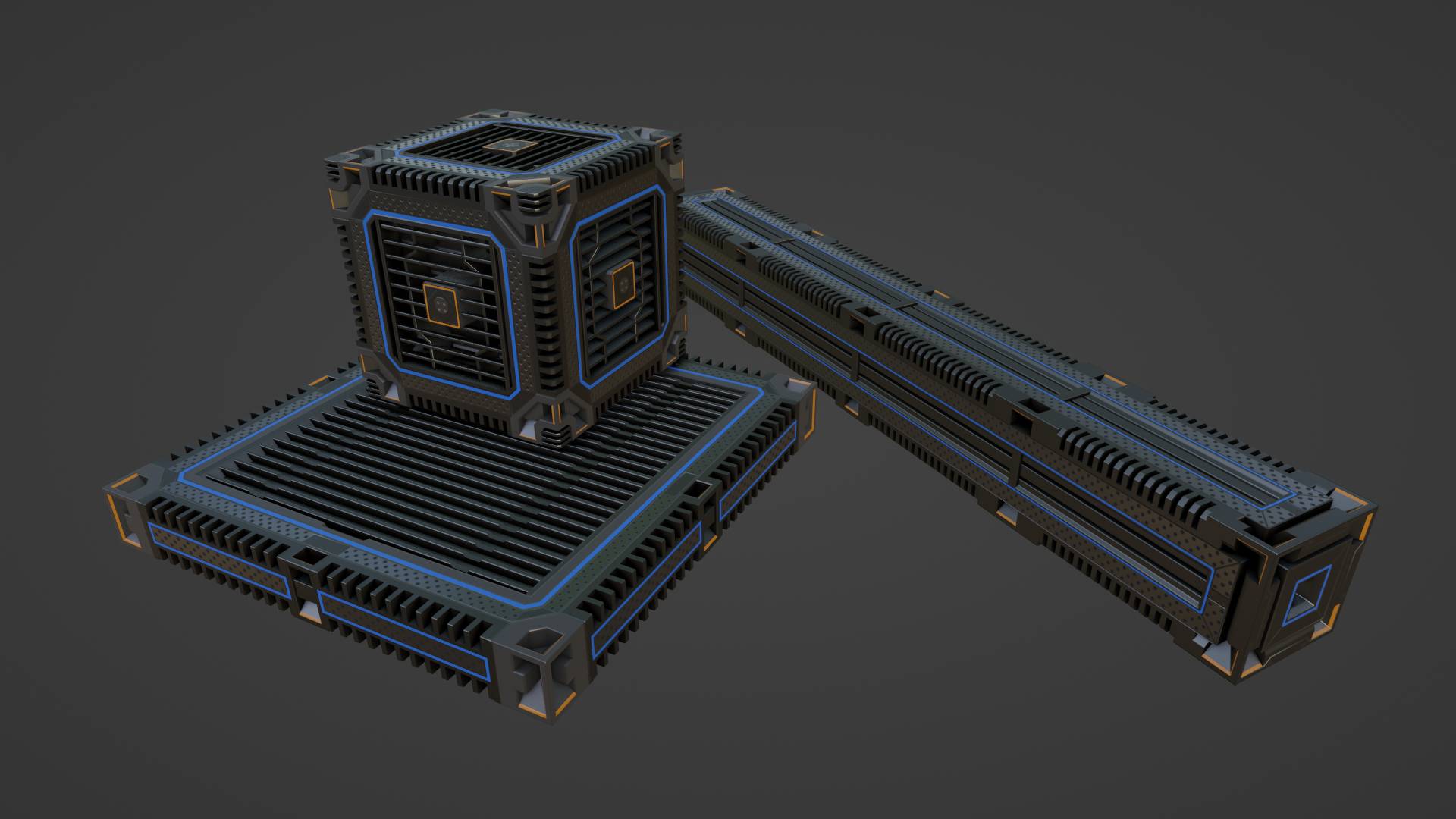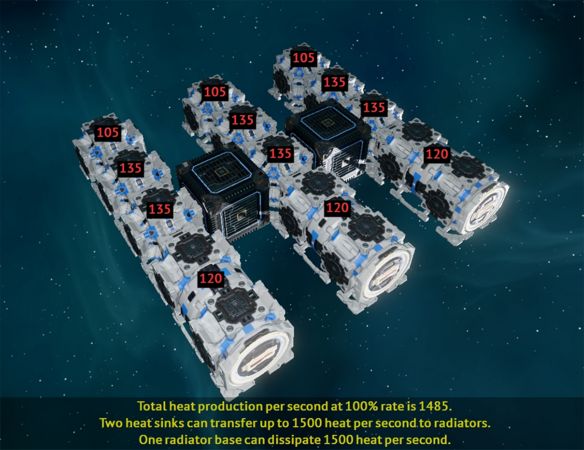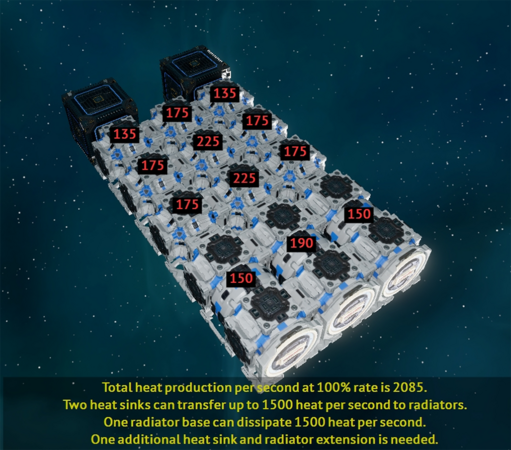Heat mechanics
Heat is a byproduct of the operation of many devices and machines, and must be dissipated to maintain peak efficiency. It is created primarily during the operation of generators and mounted weapons, and can be stored in a heatsink, dissipated with radiators, or (in the case of generators) rapidly nullified with coolant cells. Devices are also capable of dispersing some small amount of heat by themselves, though it should not be relied upon as a viable thermal control for a ship.
Production of Heat
Currently, only generators and mounted weapons produce heat that must be dispersed, the former of which produces a quantity of heat that is generally proportional to the amount of electricity it is producing (for example, tier 3 generator units produce both the highest amount of electricity and heat per unit as compared to other tiers of generator units).
Effects of Proximity on Heat
For generator units, adjacency is an important consideration for a well-balanced system. Each device in an assembled generator (fuel chambers, enhancers, or even other generator units) will not only add its own heat to the equation, but will also insulate connected devices. This 'insulation' will increase the amount of heat that each directly adjacent device produces, proportional to the number of the devices that are contributing to the insulating effect. A well-designed generator assembly must take this into consideration, as densely packed generators will produce exponentially more heat per device when compared to those with isolated devices.
Effects of Enhancers on Heat
Enhancers are used to quickly boost the rate of production of electricity in a generator unit by increasing the efficiency with which they utilize fuel, and can be easily turned on and off with YOLOL. However, while a generator unit with an attached and activated enhancer unit will produce significantly more electricity, it will also suffer an exponential increase in heat output, which in turn will affect nearby generator units. Enhancers should thus only be used in short bursts, or otherwise with a sufficiently powerful cooling system.
Dispersion of Heat
All heat-producing devices have a specific heat capacity which allows it to buffer heat generated from itself or adjacent devices, much like a battery can store electricity. These devices can also radiate some small amount of heat on their own, providing a constant passive cooling rate. Though this effect is constant, heat must be managed via the ship's pipe network, and be transferred to a heatsink, radiator, or cooling cell in order to be effectively dissipated. However, these devices can only transfer a small portion of their generated heat directly to a radiator, after which point the heat will begin to accumulate in the device's heat capacity. A heatsink must instead be utilized to capture the excess heat, as these devices have both a very high heat capacity as well as the ability to transfer vastly more thermal energy to a radiator than any other device could. After heat has been transferred (whether it be directly or via a heatsink), it can be dissipated extremely quickly by the radiator.
Thermal Soak
As mentioned before, all devices have a certain capacity for heat, which can be filled up by its own operation or by the operation of devices connected to it. Once this capacity has been saturated, the device will overheat and shutdown until the heat stored within it has been managed. Since all heat-producing devices can dissipate some amount of heat on their own and have this specific amount of heat capacity, many devices can be operated without being dependent on a dedicated cooling system. However, this naturally comes at the caveat of putting an extreme limitation on the usage of the device in question: Generators will only be able to produce electricity at a fraction of their normal operating capacity, and weapons will only be able to fire periodically (if at all).
YOLOL
All devices that produce heat have device fields to monitor properties such as thermal load and storage. YOLOL plays a key role in the management of heat, as it can be used not only to monitor the generation and storage of heat in any particular device, but also to finely modulate the transfer of heat itself, be that by adjusting the transfer rate to or from a heatsink or radiator, or by adjusting coolant flow from a coolant cell. With the proper YOLOL, all generator characteristics pertaining to heat management can be automatically maintained.
Producing Heat
Power Generation
| Device | Heat Production (maximum, per second) |
Heat Storage | Heat Dissipation (per second) |
Transfer Rate (to radiator, per second) |
Transfer Rate (to heatsink, per second) |
|---|---|---|---|---|---|
| Generator Unit (Tier 1) | 80 | 1,500 | 5 | 75 | 1,500 |
| Generator Unit (Tier 2) | 90 | 1,500 | 5 | 75 | 1,500 |
| Generator Unit (Tier 3) | 100 | 1,500 | 5 | 75 | 1,500 |
| Fuel Chamber (Tier 1) | 95 | 1,500 | 5 | 30 | 1,500 |
| Fuel Chamber (Tier 2) | 95 | 1,500 | 5 | 30 | 1,500 |
| Fuel Chamber (Tier 3) | 80 | 1,500 | 5 | 30 | 1,500 |
Ship Weapons
| Device | Heat Production (per shot) |
Heat Production (sustained) |
Electricity Consumption (per shot) |
Electricity Consumption (sustained) |
Heat Storage | Heat Dissipation (per second) |
Transfer Rate (to radiator, per second) |
Transfer Rate (to heatsink, per second) |
|---|---|---|---|---|---|---|---|---|
| Autocannon | 125 | 1,000 | 94 | 1,002 | 1,000 | 10 | 50 | 1,000 |
| Laser Cannon | 80 | 500 | 440 | 3,000 | 1,000 | 10 | 50 | 1,000 |
| Plasma Cannon | 800 | 941 | 2,000 | 2,603 | 1,000 | 10 | 50 | 1,000 |
| Rail Cannon | 600 | 336 | 20,000 | 12,700 | 1,000 | 10 | 50 | 1,000 |
Dissipating Heat
| Device | Heat Storage | Heat Dissipation (max, per second) |
Transfer Rate (to radiator, per second) |
Coolant Capacity | Coolant Transfer (to generator, per second) |
Recharge Rate |
|---|---|---|---|---|---|---|
| Heat Sink, Beam Type | 15,000 | 50 | 750 | — | — | — |
| Heat Sink, Cube Type | 15,000 | 50 | 750 | — | — | — |
| Heat Sink, Plate Type | 15,000 | 50 | 750 | — | — | — |
| Radiator Base | 1,500 | 1,500 | 1,500 | — | — | — |
| Radiator Extension | 1,500 | 500 | 1,500 | — | — | — |
| Cooling Rack | — | 25,000 [1] | — | 10,000 * 3 | 5,000 | 1 / 15 [2] |
- Calculated total at maximum flow rate
- Small coolant cells will recharge on their own at a rate of 1 per second. However, when used with a coolant recharge rack, this is boosted to 15 per second


